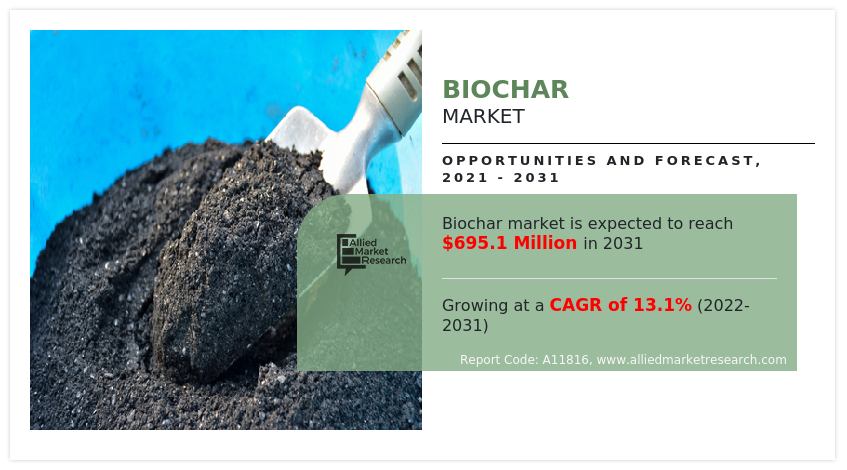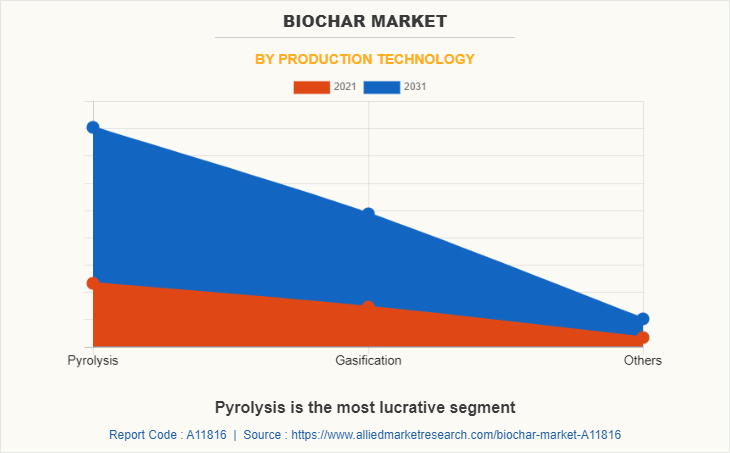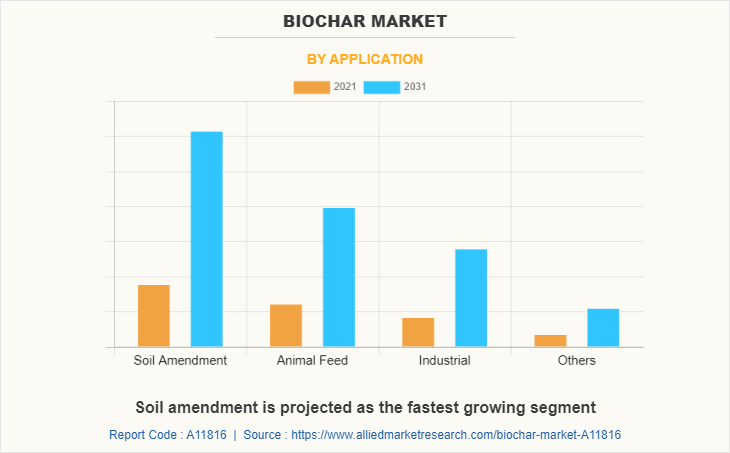Biochar Market Research - 2031
The global biochar market size was valued at $204.6 million in 2021, and is projected to reach $695.1 million by 2031, growing at a CAGR of 13.1% from 2022 to 2031. Soil fertility and crop yield improvement are key benefits of using biochar in agricultural practices. One of the primary ways biochar enhances soil quality is by improving water retention. Biochar’s porous structure allows it to absorb and hold significant amounts of water, which is gradually released into the soil.

Introduction
Biochar is a charcoal produced from the pyrolysis of biomass in the absence of oxygen. It is porous and carbon rich solid that possesses cation exchange capacity (CEC). It is widely used in soil amendment applications to enhance the soil quality, and plant nutrition. In addition to this, it is used as a prime animal feed supplement to enhance the digestion, blood formation, and nutrition intake efficiency of cattle.
One of biochar’s most significant environmental contributions lies in its potential to mitigate climate change. As a product of carbon sequestration, biochar locks carbon dioxide (CO2) from organic matter that would otherwise decompose and release CO2 back into the atmosphere. When applied to soil, biochar acts as a carbon sink, trapping the carbon for extended periods. This helps reduce greenhouse gas emissions, playing a crucial role in global strategies to mitigate climate change. Biochar has extensive applications in agriculture, where it enhances soil fertility and quality. Its porous structure increases soil aeration, water retention, and nutrient-holding capacity. These benefits make biochar an excellent soil amendment, particularly in degraded or nutrient-poor soils. Farmers in regions prone to drought benefit from biochar’s ability to retain moisture, ensuring crops have adequate water supply even in dry conditions.
Moreover, biochar improves soil microbial activity. The tiny pores in biochar provide habitats for beneficial microorganisms that are essential for nutrient cycling and plant health. These microbes break down organic matter and convert nutrients into forms that are readily available to plants. By fostering a healthy microbial environment, biochar indirectly supports plant growth and boosts agricultural productivity.
Key Takeaways
- The biochar market study covers 20 countries. The research includes a segment analysis of each country in terms of both value and volume for the projected period 2022-2031.
- The study integrated high-quality data, professional opinions and analysis, and critical independent perspectives. The research approach is intended to provide a balanced view of global biochar markets and to assist stakeholders in making educated decisions in order to achieve their most ambitious growth objectives.
- Over 3,700 product literatures, annual reports, industry statements, and other comparable materials from major industry participants were reviewed to gain a better understanding of the biochar market.
- The biochar market report is highly fragmented, with several players including FARM2ENERGY Private LIMITED, Pacific Biochar Production, Karr Group Co. (KGC), Proactive Agriculture, Airex Energy Inc., Coaltec Energy USA, Frontline Bioenergy Ltd., Arsta Eco Pvt. Ltd., Biochar Supreme, and Carbofex Ltd. Also tracked key strategies include acquisitions, product launches, mergers, expansion and others, of the players operating in the biochar market.
Market Dynamics
Increase in demand for wastewater management is expected to drive the growth of the biochar market during the forecast period. Biochar production offers an innovative solution to the growing challenge of waste management, particularly for organic waste streams such as agricultural residues, forestry byproducts, and other forms of biomass. The process of creating biochar involves the thermal decomposition of these organic materials through pyrolysis, a method that operates in the absence of oxygen. This conversion of waste into biochar not only prevents organic waste from being burned or landfilled, where it would generate harmful greenhouse gas emissions, but also transforms it into a valuable, carbon-rich material with significant agricultural and environmental benefits. One of the major advantages of using biomass waste to produce biochar is its ability to divert large quantities of organic waste from traditional waste disposal methods. Agricultural waste, such as crop residues, husks, and other plant material, often remains underutilized or disposed of through burning, contributing to air pollution and carbon emissions. In 2022, as per the Ministry of Jal Shakti of the Government of India reported that 61.52% of the rural population had access to safe and adequate drinking water within their premises, up from 55.23% in FY 2021. The Indian government has set an ambitious goal to provide 100% of its population with safe and adequate drinking water by 2024 or 2025. This initiative is expected to drive growth in municipal water treatment plants across the country, subsequently increasing the demand for biochar in water treatment applications.
However, high production costs of biochar are expected to hamper the growth of the biochar market during the forecast period. One of the primary challenges facing the biochar industry is its high production costs, which stem from the need for specialized technology and equipment. The process of producing biochar involves pyrolysis, a thermal decomposition of organic materials in the absence of oxygen. This requires advanced machinery to ensure proper temperatures and conditions are met. The equipment itself, along with the energy required to run it, represents a significant upfront investment, particularly for producers aiming to scale operations. In contrast, other soil amendments, such as synthetic fertilizers or compost, can be produced or acquired at much lower costs, making biochar less competitive in price-sensitive markets.
Segments Overview
The biochar market is segmented on the basis of production technology, application, and region. On the basis of production technology, the market is categorized into pyrolysis, gasification, and others. On the basis of application, it is divided into soil amendment, animal feed, industrial, and others. Region-wise, the market is studied across North America, Europe, Asia-Pacific, and LAMEA.

By production technology, the pyrolysis segment was the largest revenue contributor in 2021 and is anticipated to grow at a CAGR of 13.3% during the forecast period. The increase in global energy need has led the power generation sector to focus on sustainable energy sources, where biochar is widely used in producing renewable energy. For instance, according to a report published by the International Energy Agency (IEA) in 2021, renewable electricity generation in 2021 expanded by 8% and reached 8,300 TWh, which is the fastest year-on-year growth since 1970s. This may act as one of the key drivers responsible for the growth of the biochar market in the growing power generation sector.

By application, the soil amendment application segment dominated the global market in 2021 and is anticipated to grow at a CAGR of 13.4% during the forecast period. The increase in government spending to promote agricultural activities in both developed and developing economies has led the agricultural sector to witness a significant increase in demand where biochar is widely used to enhance soil fertility. Biochar is increasingly recognized for its role in soil amendment, offering several benefits for agricultural and environmental applications. Derived from the pyrolysis of organic materials such as wood, agricultural waste, or other biomass, biochar is a highly porous, carbon-rich substance. Its application to soil helps improve soil structure, enhance water retention, and increase nutrient availability. These properties are particularly beneficial in degraded soils or arid environments where water scarcity is a challenge.

Region-wise, Asia-Pacific dominated the biochar market accounting for more than half of the market share in 2021 and it is projected to grow at the highest CAGR of 13.2% during the forecast period. Biochar usage in Asia-Pacific countries has been gaining significant momentum, driven by the region’s focus on sustainable agriculture, carbon sequestration, and soil health. Biochar, a carbon-rich material produced through the pyrolysis of organic biomass, has found diverse applications in the Asia-Pacific, particularly in countries such as China, India, Japan, Australia, and Southeast Asia. One of the primary uses of biochar in these regions is in agriculture, where it is employed as a soil amendment to improve fertility, water retention, and crop yields. In highly populated and agricultural-intensive nations such as India and China, biochar is increasingly being used to enhance degraded soils and mitigate the adverse effects of excessive chemical fertilizers.
Competitive Analysis
The global biochar market profiles leading players that include FARM2ENERGY Private LIMITED, Pacific Biochar Production, Karr Group Co. (KGC), Proactive Agriculture, Airex Energy Inc., Coaltec Energy USA, Frontline Bioenergy Ltd., Arsta Eco Pvt Ltd, Biochar Supreme, Carbofex Ltd. The key players have adopted strategies such as product launch to increase their market share. The global biochar market report provides in-depth competitive analysis and profiles of these major players.
Industry Trends of Biochar Market
- In November 2023, BIOSORRA inaugurated a biochar production plant in Thika, Kiambu County, Kenya. The biochar produced at this facility will be supplied to Kenya Nut Company, a multinational agribusiness engaged in cultivating a diverse array of crops.
- In November 2023, Pyreg GmbH introduced its Biochar Carbon Removal (BCR) initiative, utilizing its carbonization systems. The company also announced its Climate Finance Solutions (PCFS), designed to enhance the adoption of this technology within the agriculture sector.
- In June 2022, Airex Energy became a technology group partner in the BDO Zone Strategic Alliance, which consists of prominent companies in the bioenergy sector. This collaboration aims to mitigate risks associated with the development of biobased projects within BDO Zones.
Key Benefits For Stakeholders
- This report provides a quantitative analysis of the market segments, current trends, estimations, and dynamics of the biochar market analysis from 2021 to 2031 to identify the prevailing biochar market opportunities.
- Market research is offered along with information related to key drivers, restraints, and opportunities.
- Porter's five forces analysis highlights the potency of buyers and suppliers to enable stakeholders to make profit-oriented business decisions and strengthen their supplier-buyer network.
- An in-depth analysis of the biochar market segmentation assists to determine the prevailing market opportunities.
- Major countries in each region are mapped according to their revenue contribution to the global market.
- Market player positioning facilitates benchmarking and provides a clear understanding of the present position of the market players.
- The report includes an analysis of the regional as well as global biochar market trends, key players, market segments, application areas, and market growth strategies.
Biochar Market Report Highlights
| Aspects | Details |
| Market Size By 2031 | USD 695.1 million |
| Growth Rate | CAGR of 13.1% |
| Forecast period | 2021 - 2031 |
| Report Pages | 272 |
| By Production Technology |
|
| By Application |
|
| By Region |
|
| Key Market Players | Airex Energy Inc., Frontline Bioenergy Ltd., FARM2ENERGY Private LIMITED, Pacific Biochar Production, Arsta Eco Pvt Ltd, Karr Group Co. (KGC), Proactive Agriculture, Coaltec Energy USA, Carbofex Ltd., Biochar Supreme |
Analyst Review
According to CXOs of leading companies, the global biochar market is expected to exhibit high growth potential. Biochar, due its water holding capacity, nutrient cycling, penetration resistance, and enhanced stability, is used in soil conditioning purposes. Soil that requires nutrient conservation can be accomplished with the use of biochar. Moreover, biochar gets enriched with nitrogen-rich organic compounds during the digestion process that enhances the toxin adsorption, digestion, and blood values in cattle (cows and goats). This factor makes it best-suited for use as a regular feed supplement for improving animal health and nutrient intake efficiency.
In addition, biochar is employed as an alternative to activated carbon for use in heating, ventilation, air condition (HVAC) units, and water treatment facilities. Moreover, factors such as increase in awareness for using sustainable products, easy availability, and novel inventions for application of biochar in several end-use industries may enhance the performance of biochar market. CXOs further added that sustained economic growth and rise in awareness for using eco-friendly products have increased the popularity of biochar among several end-use sectors.
The interest in biochar production from organic waste and biomass has been growing in recent years due to its broad availability, applicability, and smoother production, hence production techniques are being continuously improved to enhance the production efficiency and quality.
The soil amendment application segment dominated the global market in 2021 and is anticipated to grow at a CAGR of 13.4% during forecast period.
The Asia-Pacific biochar market size is projected to grow at the highest CAGR of 13.2% during the forecast period and accounted for more than half of the global biochar market share in 2021.
The biochar market is estimated to reach $695.10 million by 2031.
The leading players that are operating in the market include FARM2ENERGY Private LIMITED, Pacific Biochar Production, Karr Group Co. (KGC), Proactive Agriculture, Airex Energy Inc., Coaltec Energy USA, Frontline Bioenergy Ltd., Arsta Eco Pvt Ltd, Biochar Supreme, Carbofex Ltd.
Loading Table Of Content...
Loading Research Methodology...



